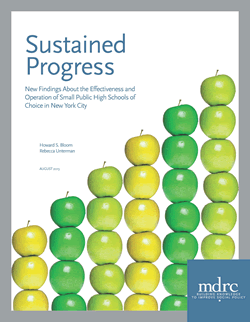Graduation Rates at Small Schools, Which Serve Highly Disadvantaged Students, Are 9.5 Percentage Points Higher Than Other Schools for Comparable Students
Sustained Progress
New Findings About the Effectiveness and Operation of Small Public High Schools of Choice in New York City

In 2002, New York City embarked on an ambitious and wide-ranging series of education reforms. At the heart of its high school reforms were three interrelated changes: the institution of a districtwide high school choice process for all rising ninth-graders, the closure of 31 large, failing high schools with an average graduation rate of 40 percent, and the opening of more than 200 new small high schools.
Over half of the new small schools created between the fall of 2002 and the fall of 2008 were intended to serve students in some of the district’s most disadvantaged communities and are located mainly in neighborhoods where large, failing high schools had been closed. MDRC has previously released two reports on these “small schools of choice,” or SSCs (so called because they are small, are academically nonselective, and were created to provide a realistic choice for students with widely varying academic backgrounds). Those reports found marked increases in progress toward graduation and in graduation rates for the cohorts of students who entered SSCs in the falls of 2005 and 2006. The second report also found that the increase in graduation rates applied to every student subgroup examined, and that SSC graduation effects were sustained even after five years from the time sample members entered high school.
This report updates those previous findings with results from a third cohort of students, those who entered ninth grade in the fall of 2007. In addition, for the first time it includes a look inside these schools through the eyes of principals and teachers, as reported in interviews and focus groups held at the 25 SSCs with the strongest evidence of effectiveness.
In brief, the report’s findings are:
- SSCs in New York City continue to markedly increase high school graduation rates for large numbers of disadvantaged students of color, even as graduation rates are rising at the schools with which SSCs are compared.
- The best evidence that exists indicates that SSCs may increase graduation rates for two new subgroups for which findings were not previously available: special education students and English language learners. However, given the still-limited sample sizes for these subgroups, the evidence will not be definitive until more student cohorts can be added to the analysis.
- Principals and teachers at the 25 SSCs with the strongest evidence of effectiveness strongly believe that academic rigor and personal relationships with students contribute to the effectiveness of their schools. They also believe that these attributes derive from their schools’ small organizational structures and from their committed, knowledgeable, hardworking, and adaptable teachers.







